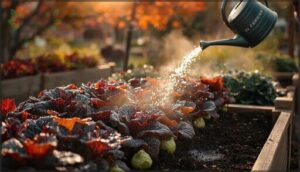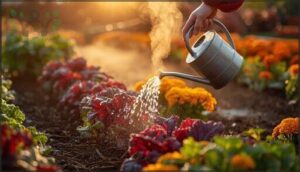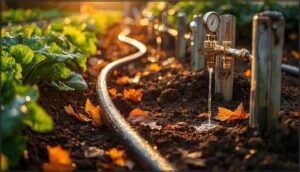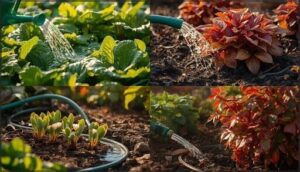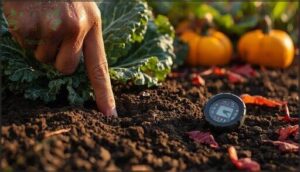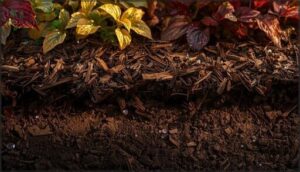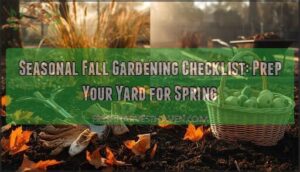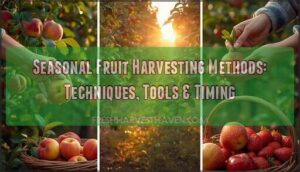This site is supported by our readers. We may earn a commission, at no cost to you, if you purchase through links.
Most gardeners ease off the hose when temperatures drop, assuming plants wind down for the season and need less attention. That instinct costs you come spring.
Fall watering isn’t about keeping foliage lush—it’s about fortifying root systems while soil remains workable and preventing the kind of winter desiccation that leaves evergreens browned out by February.
The shift from summer’s frequent shallow watering to fall’s strategic deep soaking requires recalibrating your approach based on temperature, rainfall, and plant type. Get the timing and technique right now, and your garden emerges from dormancy with established roots ready to support vigorous growth instead of spending months playing catch-up.
Table Of Contents
- Key Takeaways
- Why Fall Watering Matters for Gardens
- Adjusting Your Fall Garden Watering Schedule
- Best Watering Techniques for Fall
- Watering Different Plant Types in Fall
- Monitoring Soil Moisture and Avoiding Overwatering
- Enhancing Water Retention With Mulching
- Frequently Asked Questions (FAQs)
- How often should I water my garden in the fall?
- How long should I run my sprinklers on my vegetable garden?
- Should I water my garden every day in 90 degree weather?
- When should I stop watering my yard in the fall?
- How do you water a plant in the fall?
- Do I need to water my Garden in the fall?
- How often should you water a plant in the fall?
- Should you water your plants during a dry fall?
- How do you water a small garden?
- How often should I water my Garden?
- Conclusion
Key Takeaways
- Fall watering focuses on deep, infrequent soaking (once weekly, 6-12 inches deep) to build robust root systems and prevent winter desiccation, rather than the shallow, frequent watering used in summer.
- You should continue watering until the ground freezes, reducing frequency by 25-30% monthly as temperatures drop, while ensuring soil reaches 70% field capacity before winter to protect evergreens from up to 50% foliage loss.
- Early morning watering (5-9 a.m.) combined with drip systems or soaker hoses cuts water use by 30-70%, reduces fungal disease risk by 40%, and keeps foliage dry during fall’s cooler, damper conditions.
- Applying 2-3 inches of organic mulch before the ground freezes boosts soil moisture retention by 20-82%, moderates temperature swings during freeze-thaw cycles, and can reduce supplemental watering needs by up to two-thirds.
Why Fall Watering Matters for Gardens
You might think watering matters most in summer, but fall irrigation sets the stage for your garden’s survival through winter and its comeback in spring. When you keep the soil consistently moist during autumn, you’re not just maintaining plants—you’re preparing them to withstand cold, desiccating winds and frozen ground ahead.
Here’s why your watering routine this season makes all the difference.
Promoting Strong Root Growth Before Winter
As autumn soil temperatures settle between 10°C and 18°C, your plants shift their energy toward root development rather than leaf production. Deep, infrequent watering—spaced 7–10 days apart—encourages roots to extend 10–30 cm deeper into the soil, building root systems that tap into moisture reserves.
This seasonal timing aids nutrient uptake and carbohydrate storage, giving your plants the foundation they need to thrive come spring. Cooler temperatures can greatly affect nutrient uptake efficiency.
Preventing Winter Desiccation
Strong roots won’t help if your plants enter winter already stressed by drought. More than a third of documented desiccation injuries trace back to autumn drought conditions that persist through the cold months.
More than a third of winter desiccation injuries begin with autumn drought that persists through the cold months
Evergreens face particular risk—up to 50% foliage loss on exposed sites—because frozen soil prevents roots from replenishing moisture lost through winter winds.
Your late fall watering protects crowns and needles by ensuring soil moisture reaches at least 70% of field capacity before the ground freezes, reducing desiccation damage considerably. This is especially important because evergreens are susceptible to winter desiccation.
Supporting Soil Microbial Activity
If your soil dries out in fall, you’re not just risking plant stress—you’re starving the microbes that build fertility. Microbial Water Needs shift with cooling temperatures and soil texture. Mulch Benefits go beyond water retention, supporting microbial activity even through Freeze-Thaw Cycles. That’s why you want:
- Lively soil teeming with microbes
- Resilient root systems
- Enhanced nutrient cycling
Adjusting Your Fall Garden Watering Schedule
As fall settles in, your garden doesn’t need the same watering approach you used during the heat of summer. Cooler temperatures, shifting rainfall patterns, and slower plant growth all mean it’s time to rethink how often and how much you water.
Let’s break down the key adjustments you’ll need to make to keep your plants healthy without overdoing it.
Factoring in Local Rainfall and Temperatures
Rainfall patterns and temperature fluctuations define your fall watering strategy. You can’t simply guess—track local climate data with a rain gauge to measure weekly precipitation, aiming for about one inch combined from rainfall and irrigation.
As temperatures drop near 40°F, plants absorb less moisture and soil retains water longer, so adjust your schedule accordingly. Weather forecast monitoring helps you anticipate seasonal variations and improve plant uptake timing.
Reducing Frequency From Summer Routines
When cooler days arrive, you’ll need to dramatically cut back from summer watering schedules—scaling down from daily sessions to just once or twice weekly. This Summer Schedule Reduction prevents overwatering while accommodating seasonal changes that naturally decrease water needs.
Key adjustments for your fall watering schedule:
- Reduce watering frequency to 1–2 times weekly versus summer’s near-daily routine
- Eliminate rainfall supplement if precipitation consistently delivers one inch per week
- Recognize weekly watering sufficiency for most established plantings
- Lower lawn watering reduction to 1–1.5 inches weekly across one or two sessions
- Monitor soil moisture at 2–3 inches depth for Overwatering Prevention
Scaling Back Irrigation Timers
As autumn settles in, you’ll want to dial back your irrigation timers by 25–30% each month to match dropping temperatures and reduced evaporation. Smart timer technologies help achieve this seasonal reduction, cutting water usage by up to 50% compared to basic systems.
Program controllers to run 10–15 minutes once or twice weekly, preventing overwatering while your climate transitions and plants prepare for dormancy.
Best Watering Techniques for Fall
How you water in fall matters just as much as how often you water. The right technique protects your plants from disease, conserves water, and builds stronger root systems before winter arrives.
Let’s look at three proven methods that work with fall’s cooler, wetter conditions.
Deep and Infrequent Watering Methods
You’ll preserve more water and grow healthier plants by saturating soil deeply rather than sprinkling lightly every day. Deep and infrequent watering pushes roots to reach down 12 to 18 inches, building stronger plants with better drought resistance.
Aim for soil saturation at 6 to 12 inches depth once or twice weekly, ensuring efficient irrigation while cutting water use by up to 30 percent compared to shallow, frequent sessions.
Early Morning Watering to Prevent Disease
You’ll slash fungal diseases by up to 40% when you water between 5 and 9 a.m., giving leaves time to dry before nightfall. Early morning watering reduces leaf wetness duration and lowers spore germination rates for pathogens like powdery mildew.
This timing cuts pest activity by 30%, since slugs and beetles thrive in damp evening conditions—making it among the best irrigation practices for fall plant care.
Efficient Use of Soaker Hoses and Drip Systems
Drip systems and soaker hoses transform fall garden watering by delivering moisture right where roots need it. You’ll cut water use by 30–70% compared to sprinklers while keeping foliage dry—slashing disease risk dramatically.
- Best Scheduling: Run drip lines 45–60 minutes weekly in fall, adjusting for rainfall
- Slope Considerations: Install air relief valves on sloped terrain to prevent uneven distribution
- System Maintenance: Check for clogs monthly and keep water pressure below 100 psi for soaker hoses
Watering Different Plant Types in Fall
Not all plants drink from the same cup when temperatures drop. Each type in your fall garden has its own moisture requirements, shaped by root depth, growth stage, and how it gets ready for winter.
Let’s break down the watering approach for each major plant category so you can keep everything thriving through the season.
Evergreens and Broadleaf Shrubs
Your evergreens and broadleaf shrubs face a hidden threat: winter desiccation. These plants lose water through transpiration even when dormant, making fall plant care critical for root hydration.
Water deeply at the drip line, delivering one to two inches weekly until the ground freezes. Monitor soil moisture at four to six inches depth—if it’s dry, irrigate.
Proper timing and irrigation methods now prevent spring damage.
New Shrubs, Trees, and Perennials
While established plants manage with moderate care, new plantings demand vigilance. Your establishment watering strategy determines survival rates—studies show 50% higher mortality when you skimp now.
- First two weeks: Water newly planted shrubs and perennials daily, ensuring soil moisture penetrates six to twelve inches.
- Weeks three through twelve: Shift to every two to three days for root development.
- Until ground freezes: Maintain weekly deep watering sessions—five gallons per shrub, ten to twenty gallons per tree.
Monitor soil at four to six inches depth. Overhead rainfall often doesn’t reach roots under mulch, so check regularly and adjust accordingly.
Fall Vegetables, Bulbs, and Annuals
Your fall garden’s smaller plants play by different rules. Cool-season vegetables like spinach and kale need about one inch of water weekly—either from rain or your hose—to keep the top six inches of soil moist. Sandy beds may demand closer to two inches. Newly sown seeds require daily attention until seedlings reach four inches tall.
Spring-flowering bulbs, planted at depths of four to six inches, appreciate one thorough post-planting soak and then weekly watering during their active root-growth window, assuming natural rainfall falls short. Fall annuals like pansies need daily watering for their first week or two, then you can dial back to two or three sessions weekly.
As temperatures drop and seasonal evapotranspiration declines by thirty to fifty percent, you’ll water less frequently than in summer—sometimes half as often. Monitor soil at two inches down; if it feels dry, water until moisture reaches six to eight inches deep. Overwatering when nights dip below fifty degrees invites root rot from water-mold pathogens, so let the surface dry slightly between sessions and aim your drip lines at soil level, not foliage, to minimize disease pressure in cool, humid conditions.
Lawns and Turf Grass
Cool-season turf grass—bluegrass, fescue, and similar varieties—thrives with one to one-and-a-half inches of water weekly through fall, either from rain or irrigation. Check soil at four to six inches; water deeply twice weekly until turf dormancy begins when temperatures consistently dip below thirty degrees Fahrenheit.
Key fall turf watering practices:
- Water between 6 a.m. and 10 a.m. to reduce disease risk
- Apply twenty to thirty minutes per session for deep root growth
- Coordinate irrigation with fall fertilization and aeration benefits
- Track rainfall—October’s 5.4-inch average often suffices
- Continue watering after overseeding lawns until grass seed germinates
Deep, infrequent sessions prevent winter desiccation and shallow rooting that invites fungal problems in cooler, damp conditions.
Pots and Container Plants
Containers demand a different approach than turf. Cooler fall weather cuts soil moisture loss in pots by thirty to fifty percent compared to summer, so your watering frequency tips shift dramatically—many potted plants go from needing water every two to three days to every five to ten days.
Check soil two inches deep with your finger before watering; pot material impact and drainage considerations determine how quickly containers dry out.
Monitoring Soil Moisture and Avoiding Overwatering
You can’t water your fall garden properly if you’re guessing at what the soil actually needs. The line between too much and too little isn’t always obvious, especially as temperatures drop and evaporation slows.
Here’s how to read your soil accurately and catch moisture problems before they damage your plants.
Soil Touch Test and Moisture Meters
You can gauge moisture by pushing your finger 2 to 3 inches into the soil—if it feels dry at that depth, it’s time to water.
For greater watering accuracy, calibrate a digital moisture meter against your soil texture and compare readings to the 21–40% range for woody plants or 41–80% for vegetables. This dual approach ensures you’re reaching the proper root depth without guessing.
Using Rain Gauges to Track Precipitation
Tracking rainfall with a rain gauge gives you the data you need to adjust watering schedules with confidence. Manual gauges with 4-inch openings deliver accuracy within 2% when placed correctly, while digital models reduce human error through automated logging.
- Gauge placement: Position in open, level ground at least 2 feet high and as far from obstacles as they’re tall
- Reading frequency: Check weekly during fall or after each significant rain event
- Data interpretation: Aim for 1–2 inches of precipitation per week; supplement when natural rainfall falls short
- Gauge maintenance: Empty after recording and clean debris regularly to preserve measurement precision
Correlating these rainfall records with soil moisture levels lets you fine-tune irrigation and prevent both drought stress and overwatering.
Signs of Overwatering and Underwatering
Yellowing leaves with soft stems point to overwatering—root rot sets in when soil moisture stays above 30% for days. Drooping leaves with crispy edges signal underwatering, especially when soil moisture dips below 23%.
Both extremes stress root health and invite fungal growth or wilting.
Check roots directly: black and soggy means too much water, while dry and cracked indicates too little.
Enhancing Water Retention With Mulching
Mulch acts as a protective blanket that locks moisture into your soil, reduces temperature swings, and gives your fall garden a fighting chance against winter’s demands. Getting the right type, depth, and timing makes all the difference in how well your plants weather the cold months ahead.
Here’s what you need to know about mulching to improve water retention and root health this season.
Best Mulch Types and Application Depth
Your mulch choice directly shapes how well your garden holds moisture through fall and winter. Shredded bark mulch leads the pack, retaining 35% more soil water than bare ground over six weeks.
Apply organic mulch types like pine needles or chopped autumn leaves at 2–3 inches deep for best water retention capacity and soil health impacts—thicker than 4 inches risks pathogen growth and reduced plant vigor.
Timing Mulch Before Ground Freezes
Your best calendar window runs from late September through mid-November, timed to soil temperature benchmarks of 40–50°F at root depth. Wait until after the first frost, when topsoil cools but before deep freeze effects set in—usually a three-week span. Premature mulching risks trapping heat and inviting disease; delaying past ground freezes reduces frost protection.
Climate zone adaptations matter: maritime regions mulch earlier, continental climates sync with snowpack.
Mulching Benefits for Roots and Soil Moisture
Organic mulch acts like a moisture bank account, depositing water where roots need it most. A 2–3″ layer delivers measurable returns across your fall garden:
- Boost soil moisture by 20–82% compared to bare ground
- Reduce evaporation losses from exposed surfaces
- Moderate root zone temperature swings during freeze-thaw cycles
- Improve soil structure through organic matter decomposition
- Cut supplemental watering needs by up to two-thirds
Frequently Asked Questions (FAQs)
How often should I water my garden in the fall?
Your fall garden generally thrives with one deep watering per week—think of it as a steady drink rather than frequent sips—but factors like rainfall, soil type, and plant needs demand close monitoring.
How long should I run my sprinklers on my vegetable garden?
Your vegetable garden needs sprinklers running 20–30 minutes on clay soil or 10–15 minutes on sandy soil. Adjust based on soil absorption and runoff prevention, ensuring moisture reaches 2–3 inches deep per session.
Should I water my garden every day in 90 degree weather?
In sustained 90°F heat, most gardens benefit from daily or every-other-day watering.
Check soil moisture 1–2 inches deep before irrigating—newly planted vegetables and shallow-rooted crops usually need daily attention to prevent wilting.
When should I stop watering my yard in the fall?
You should stop watering your yard once the ground freezes and grass enters dormancy, usually after the first frost date. Continue reduced watering until nighttime temperatures consistently drop below 50°F.
How do you water a plant in the fall?
How can you tell when it’s time to water? Check soil moisture two to three inches down—if dry, water deeply in early morning using soaker hoses or drip irrigation for best root depth and absorption.
Do I need to water my Garden in the fall?
Yes, your fall garden needs watering even as plants prepare for dormancy.
Autumn gardening depends on seasonal conditions—rainfall, soil moisture levels, and regional climate impact determine your watering frequency guide.
Most gardens need one inch weekly from rain or irrigation.
How often should you water a plant in the fall?
Frequency factors in fall watering depend on plant type and root depth, regional climate impact, and checking soil moisture regularly.
Most gardens need about one inch weekly, adjusting for dormancy considerations.
Should you water your plants during a dry fall?
Absolutely. During drought conditions, supplemental water becomes critical for plant survival rates and root development. Without adequate soil moisture in a dry fall, perennials face up to 30% reduced winter survival, making watering guidelines essential.
How do you water a small garden?
Even modest plots benefit from simple tools like watering cans or hose wands for targeted container watering.
Hand watering lets you inspect plants closely, directing moisture exactly where roots need it while conserving water and avoiding runoff.
How often should I water my Garden?
During fall, water your garden once weekly, adjusting for rainfall and soil type. Deep watering promotes root growth, while weather and temperature swings, soil drainage, and plant stage determine your exact fall garden watering schedule.
Conclusion
Like a traveler packing provisions for a long journey, your garden needs strategic hydration before winter’s arrival. This fall garden watering guide prepares you to shift from summer’s frequent surface moisture to targeted deep soaking that fortifies roots, prevents desiccation, and sustains microbial life through dormancy.
Monitor soil conditions, adjust for rainfall, and mulch before the ground freezes. The effort you invest now determines whether your plants emerge resilient or spend spring recovering from preventable stress.
- https://extension.colostate.edu/resource/fall-and-winter-watering-of-plants-and-trees/
- https://www.provenwinners.com/learn/fall/fall-watering
- https://www.epicgardening.com/fall-garden-watering/
- https://www.thepioneerwoman.com/home-lifestyle/gardening/a68137924/best-time-to-water-your-fall-garden/
- https://news.vt.edu/articles/2024/08/fall-autumn-garden-watering-irrigation-expert.html


